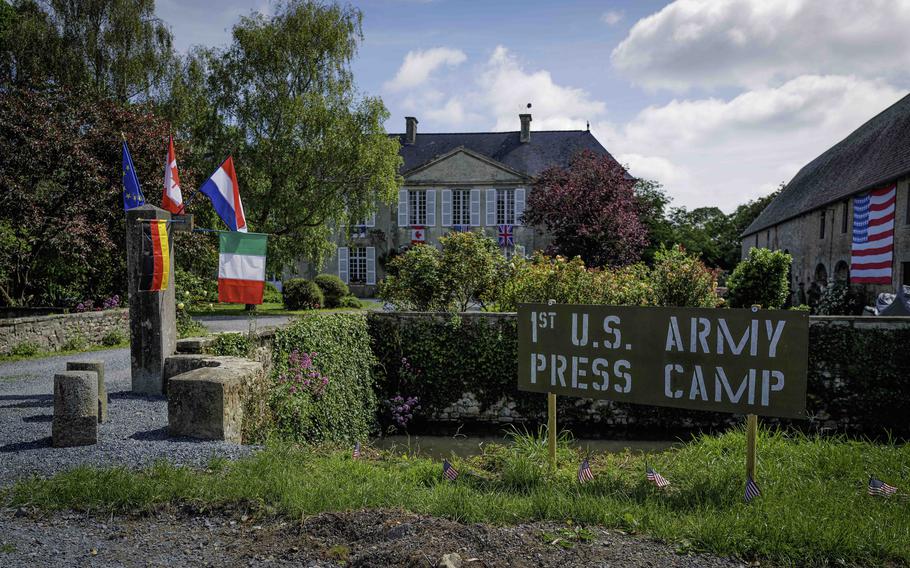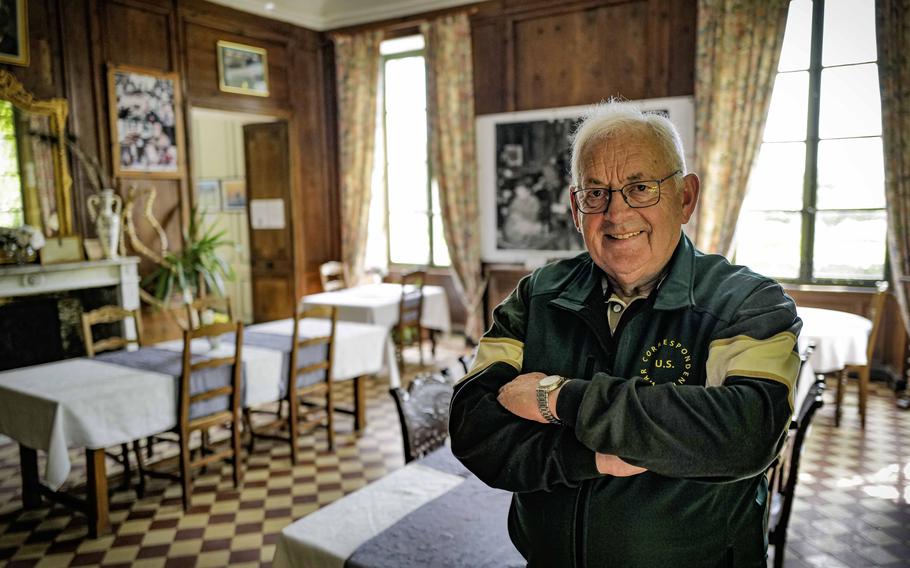
A front view of Chateau Vouilly in Normandy, France, during the commemorations of the 80th anniversary of D-Day. The chateau served as the first Allied press camp during World War II and now hosts visitors commemorating its history. (Alexander Riedel/Stars and Stripes)
SOMEWHERE IN NORMANDY, France — This nondescript dateline intentionally hid the precise location where news stories following the June 6, 1944, D-Day landings were written.
Reporters could only cable back their stories under strict security review from military censors, who didn’t want to give away troop movements.
“Somewhere” was Chateau Vouilly, a quiet hamlet surrounded by Normandy’s rolling green hills and hedgerows, just a 20-minute drive from Pointe du Hoc and Omaha Beach.
Three days after American troops landed in Normandy, the 1st Army liberated Vouilly and set up its first press headquarters. Within days, the chateau hosted war correspondents, including Ernest Hemingway and Walter Cronkite.
“It’s not on the main road, so it’s quite hidden,” said James Hamel, whose family has owned the grounds for nine decades. “The decision to set up the press camp here was strategic. They needed a place that was safe but also close enough to the action.”
The heart of operations was the small, wood-paneled dining hall. It’s where correspondents typed out their reports, detailing the brutal fighting just miles away.
“They wrote their articles and had to pass them on to the censorship next door,” Hamel explained. “Their dispatches only ever mentioned ‘somewhere in Normandy.’”
Once the dispatches were approved, the reporters could cable them back to an eager world waiting on news from the front via a wire strung through the window to a radio transmitter set up in the garden.
Today, guests eat in the room, which is part of a small bed-and-breakfast the Hamel family runs to support the maintenance of the historic building and grounds. Each morning, where the clatter of typewriters echoed so many years ago, butter knives and coffee spoons now clink gently against plates and cups.

James Hamel stands in the press copy room at Chateau Vouilly, Normandy, France, on June 3, 2024. The room once buzzed with activity as war correspondents typed their dispatches during World War II. (Alexander Riedel/Stars and Stripes)
Instead of a large map of Normandy that once helped leaders like Gen. Omar Bradley brief the reporters on troop movements, a large photo shows the newsroom in the turbulent summer of 1944.
“There is something special here. The feeling remains and you can feel that something important happened here. It’s magnetic,” said Emmanuel Pelot, a family friend who helps Hamel preserve the chateau’s legacy during commemoration events and tours. “Everybody who comes to visit seems to automatically treat this room with respect.”
Hamel’s grandmother, Alexandrine Hamel, welcomed the war reporters. Known as “Grandma” to the correspondents, she had endured the Nazi occupation of her land and showed resilience by making their stay difficult.
“My grandmother kept the room overlooking the bridge free, claiming her children were sick to keep the Germans out,” he recounted. “She didn’t want them to settle in too comfortably.”
She also supplemented the correspondents’ Army rations with the family’s homemade butter and milk, while they shared chocolate and candy with her family.
More than 54 correspondents typed their stories at Vouilly. The list is a who’s who of journalists, including writer Ernie Pyle and war photographers Robert Capa and Lee Miller, who planned assignments and developed their photos here.
Stars and Stripes reporters G.K. Hodenfield and Andy Rooney, later of CBS News fame, also worked here.
“The plan called for the Rangers to break out of Pointe d’Hoc before noon on D-Day … Then it would be a fairly simple matter — I hoped — for me to find 1st Army Press Camp and file my stories,” Hodenfield recalled in a Stars and Stripes story in 1964. “The Rangers didn’t get off Pointe d’Hoc for three days.”
Eventually Hodenfield found the press camp at Vouilly. A photo shows him working on his typewriter, jacket hastily slung across the foldable Army table.
For many journalists, the chateau’s lush grounds offered a refuge from the day’s stresses. After exiting combat zones, they returned to write their stories, grab a meal and sleep in safety, Pelot explained.
“Every night, Mme. Hamel stood smiling in the background as her son, Dumilly, who had been a prisoner of the Germans for three years, toured the work tables with glasses of milk and plates of cookies for the dusty correspondents,” Associated Press reporter Hal Boyle recalled after revisiting the site in 1954.
On the tougher days, Hamel served glasses of Calvados, the famed local spirit made from distilled apple and pear cider. Reporters called it the “breakfast of champions.”
While they enjoyed the calm of the chateau, the war moved fast and with it the journalists. Two months after they had set up camp, the front lines shifted.
As fast as they had come, the reporters packed their cameras and typewriters to move toward Paris with the advancing troops.
What remained to this day was the sign on the door, reading: “Copy room.”
“Many journalists returned over the years, sharing their memories and expressing their gratitude,” Hamel said.
A bronze plaque, placed with help from Walter Cronkite in 1994, commemorates the chateau’s history as a press camp. Maintaining the chateau, with foundations dating back to the 10th century, is a labor of love for the Hamel family.
“My family bought the castle in 1934,” Hamel explained. “It’s been a dairy farm for generations, and my granddaughter will be the fifth generation to take over the business.”
Today, their 150 cows graze in the surrounding fields. Despite financial constraints and the need for constant upkeep of the chateau, the family remains committed to preserving its legacy.
During the D-Day 80th anniversary celebration, the Hamel family opened a temporary exhibit honoring the correspondents. Mannequins in uniforms, typewriters and cameras re-create the scene.
One centerpiece is a table thought to have been used by Pyle, who was revered for his ability to tell the stories of ordinary soldiers on the battlefields of Europe and the Pacific before his death on Okinawa in 1945.
Much like his grandmother, James Hamel continues to welcome visitors, sharing the stories of the correspondents who chronicled the heroism and tragedies of D-Day.
“Many visitors come to see the battle sites and battlements with big guns. Of course, there were no guns or battles here,” Pelot said. “Journalism played a critical role during the war, and the information shared from here was as vital as any weapon. It’s not a museum; it is still alive.”